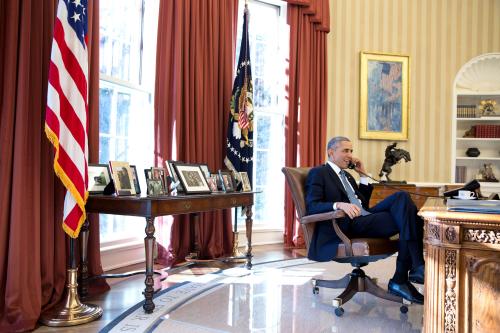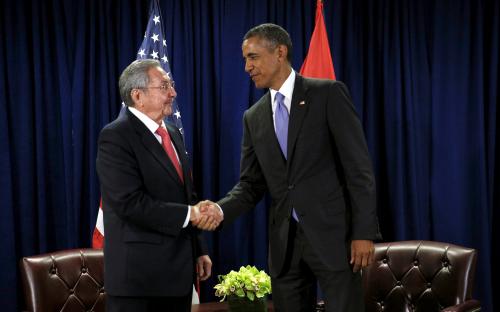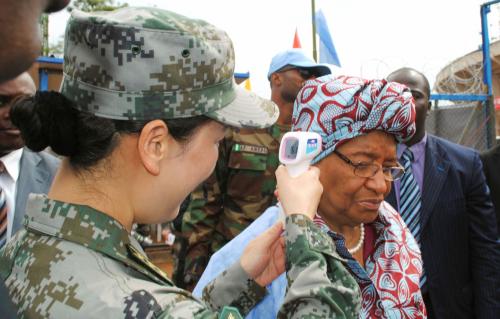Editors’ Note: The odds of wringing short-term concessions from Cuba’s proud and nationalist leaders are stacked against Obama, Richard Feinberg and Ted Piccone believe. They argue the trip should be judged by its ability to expand constituencies in both countries who want a more open and prosperous Cuba. This post originally appeared on Huffington Post.
President Obama’s decision to make a historic visit to Cuba later this month is about more than U.S. politics or business opportunities on the island. It’s a bold bet that presidential diplomacy can secure a new normal in U.S.-Cuba relations after over five decades of hostilities, embargoes and gridlock.
Based on our years of analysis and policymaking in and out of government, we believe the odds of wringing short-term concessions from Cuba’s proud and nationalist leaders are stacked against Obama. We also believe, however, that that is the wrong metric. Rather, this trip should be judged by its ability to expand constituencies in both countries who want a more open and prosperous Cuba.
To that end, Obama should draw on his extraordinary rhetorical skills to paint a vision for both Cubans and Americans of a future attractive enough to persuade the island’s citizens, especially its ambitious and talented millennials to remain on the island and for the resourceful Cuban American diaspora to invest in that vision. This promise of a Cuban renaissance should include one where citizens freely exercise their chosen professions, engage directly with a transparent and accountable government, have access to the global internet, and travel abroad routinely for family and business purposes.
To help shape such a future, the U.S. delegation should engage not only with Cuba’s historic revolutionaries but also with its next generations of public and private leaders from across Cuban society. The White House can also use the visit to leverage Obama’s immense popularity on the island to speak directly to the Cuban people about their aspirations for a brighter future.
Given the longstanding feuds between our two countries, however, it will take longer than a year or two to unwind the accumulated distrust and build support for this new normalcy. On the U.S. side, major sectors have swung clearly in favor of normalization – business and agricultural interests, human rights and religious groups, and the broad swath of U.S. citizens keen to know Cuba after decades of isolation. Even majorities of Cuban-Americans and Hispanic voters favor engagement over the embargo.
These constituencies, however, are not yet strong enough to persuade Congress to lift the embargo. And Havana has done little so far to address the major sticking points in Washington’s list of legitimate grievances, particularly in the key areas of human rights and economic reforms.
On the Cuban side, Raúl Castro recognizes that Cuba’s ability to protect the social gains of the revolution depends on normalizing its participation in the global economy. Its economy badly needs the injection of U.S. commerce, professional exchanges and tourism that would flow readily once the embargo is lifted. Family-run businesses, farmers, young people and professionals in sectors like software and biotechnology also stand to gain from these changes.
Notably, many of those fighting for a more pluralistic Cuba applaud Obama’s decision to declaw the embargo as a political shield for government hard-liners; it helps their cause for a more honest debate at home about how to reform Cuba’s outdated model of state-centric development and to make government more accountable to its citizens.
The visit offers both presidents a rare opportunity to demonstrate to these various stakeholders that change is not one-sided but a mutual accommodation. There is nothing like a presidential visit to move bureaucracies and catalyze action.
For example, the visit could accelerate progress toward easing the embargo. Already, new rules encourage trade with the emerging private sector and with some state-owned enterprises. Cuba should now take steps to facilitate such commerce and stop insisting that all sanctions be lifted first.
As important, the two sides should expedite resolution of outstanding U.S. property claims dating back to the early 1960s, a key congressional condition for lifting sanctions. Prompt resolution of these cases would automatically create powerful constituencies in the United States for repealing the embargo and signal to foreign investors that Cuba is prepared to respect property rights and the rule of law. They could also demonstrate a willingness to resolve longstanding claims for compensation for citizens killed in hostilities during the Cold War.
In anticipation of next month’s Cuban Communist Party Congress, President Castro can detail his plans to decentralize power, empower the legislature and reform the electoral system.
The precise timing of Obama’s visit – just one month before the Party Congress – may signal that Raúl Castro and his pragmatic followers welcome a friendly nudge to recharge the reform process they launched in 2008. It also underscores how little time remains before Americans elect a new president who could reverse steps taken so far with the stroke of a pen. That is the kind of marriage of short and long-term interests that allow wise presidents to make history, and the ultimate test for assessing whether the Obamas’ trip is serious business, or just family fun.






Commentary
In Cuba, Obama looks to the post-Castro era
March 16, 2016